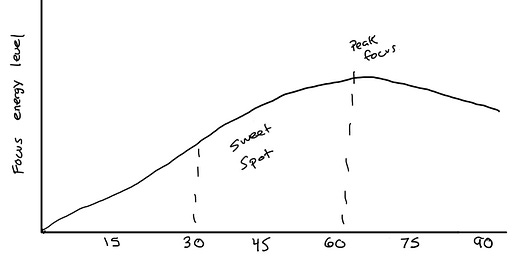True focus means saying “no” to everything to say “yes” to one thing.
It takes a mighty effort. I used to squander my effort by setting aside too little time when I got it. Now, I’ve figured out 60 minutes is the sweet spot for focus.
Let’s talk about why 60 minutes works, what keeps us from setting time for focus, and how to fit it into your workday.
60 minutes is the Goldie Lock Zone
iPhones can be put on a different focus mode with a tap. Unfortunately, our brains don’t work on a switch. There is a gradual ramp-up.
A mind doesn’t truly get locked in until 30 minutes in and starts losing focus after 75 minutes. The magic zone is past 30 minutes. Anything shorter robs you of getting to peak focus.
Along with getting into a groove, we wildly underestimate how long things take.
I always think building 2-3 presentation slides should take 30 minutes, but it’s always closer to 60 minutes when I account for re-reading, proofing content, and making layout adjustments.
Across most tasks, we underestimate. There is a term for this error — the planning fallacy.
A good rule of thumb is to assume most things will take a solid hour to finish or make progress on. Better to set aside more time versus too little.
Why We Don’t Do It
60 minutes is intimidating when the task gives you anxiety.
This is why blocking your calendar is equivalent to organizing your notes. It’s the easy part.
Starting is what’s hard.
But objectively, it’s not. If we go back to building slides for work. This is what starting truly means.
Open the slide deck.
Get to the slide you need to work on and put your cursor on the object.
It's easy stuff, but our minds resist. It forecast difficulty. It’s the same reason why we love Friday afternoons and hate Sunday nights.
Anticipation. We like to predict what happens next which sets our mood.
But our predictions are always off when it comes to starting a task because motivation comes after we start.
It’s similar to exercising. This summer I’ve done a lot of 10-mile runs. I never stopped after 5. The motivation came after I started. Waking up early and getting out of a comfortable bed was the hard part.
60 minutes might feel long but once you start you won’t stop.
Two Sessions Every Day
Most work days are chaos. There is always something unexpected — a random request from the Senior VP, an unscheduled meeting, or a ping from a coworker with a question.
This is modern work. Along with it comes meeting palooza.
The average time we spend in meetings has gone up 10 percent since 2020. Now most non-managers have 11-15 meetings per week. If we are conservative, 2 hours are taken by meetings every workday.
How is one supposed to get any focus time?
This is where you have to be a ninja of your calendar.
If your job allows it, for every meeting someone adds to your calendar, schedule an equal block of time for focused work until you have two 60-minute sessions blocked.
Two sessions of 60 minutes is all you need. Not only is it attainable but it’s realistic.
Most work time is filled with multi-tasking and responding to communication channels. You cannot ask yourself to drop everything for one thing more than twice a day.
You don’t have the willpower, the time, or the patience of your coworkers/boss.
Here is a simple question to ask yourself:
“If you only had 2 hours a day to work, and had to break them into 1-hour intervals, what 1 or 2 things would you focus on?”
2 hours 5 days a week is 10 hours of focused work. The days I am behind on work are the days I am behind on my 10 hours.
Give this strategy a shot. And see how it works for you.
Favorite Find
My last article was all about Seinfeld’s life advice.
This is an absolute banger of a commencement speech by him at Duke University. Worth 12 minutes of your time.
Thanks for reading!
Irfan
If my writing brought you value, please share it with someone else.
Not a subscriber? Sign up for free below.



